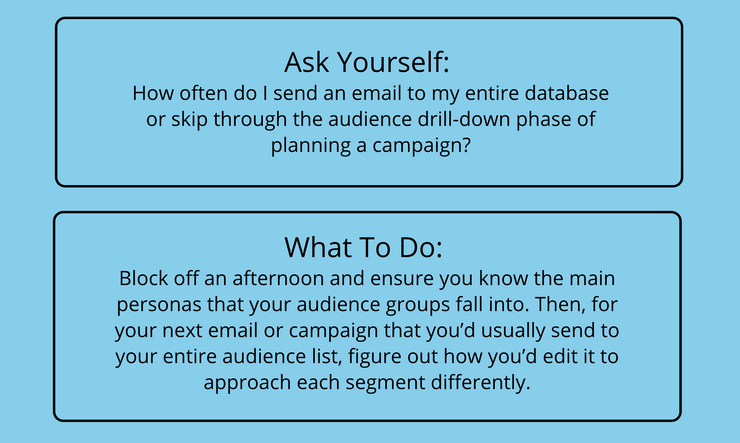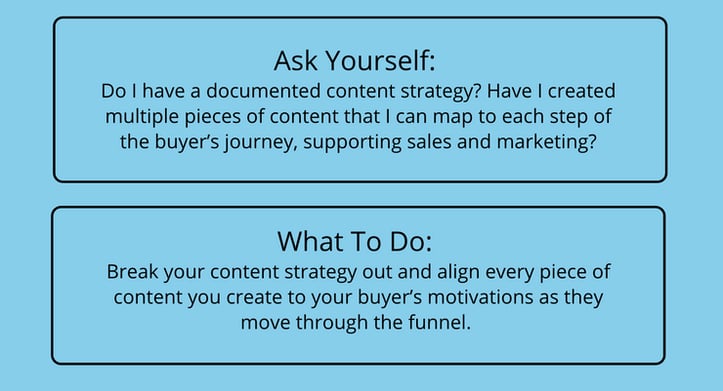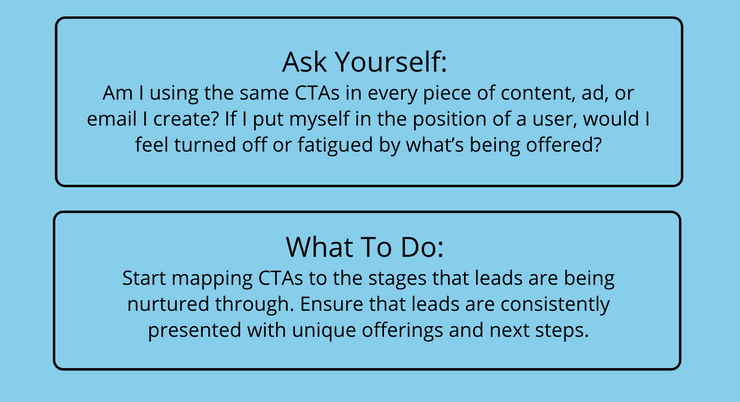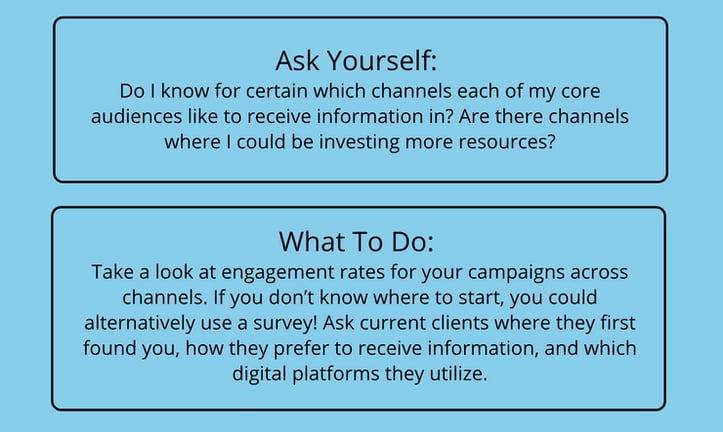5 Fails to Avoid in Digital Lead Nurturing: A Checklist for Success
When digital lead nurturing is done correctly, you can see a huge payoff — in the last several years marketers have reported up to 50% more sales-ready leads generated, at 35% lower cost. However, if you’re failing to implement a proper lead nurture strategy or are suffering from failures in execution, it could result in wasted time and poorly allocated marketing spend.
Here’s the good news: There are five common digital lead nurture fails that are easy to fix! In fact, they’re what we often start with when kicking off a project with a new client.
Walk through these digital lead nurture fails below. If they sound familiar, you can follow the next steps at the end of each section to turn that fail into a win.
Fail #1. Targeting the Wrong Audience or Blasting Everyone With the Same Message
When your team is stretched thin, it’s often tempting to create one version of a marketing campaign that you send to every audience at the same time. You may justify it as covering all your bases. After all, even if the message you’re sending doesn’t apply to a few of those leads, they’ll understand. Right?
Wrong.
When you send a message to the wrong audience, you’re creating a negative impression of your brand. These negative impressions are pervasive. Even if you match the campaign and audience correctly next time, it doesn’t matter; on average, it takes 12 positive experiences to override the impression of a single negative one.
Moreover, if the “sender” is a specific member of the sales or marketing team, you’re spoiling the relationship between them and the lead. A full 65% of business buyers report that they’re likely to switch brands if you don’t personalize communications to their company.

For tips on this, read our guide on putting personas into action.
Fail #2. A Lack of Effective Content — In Quantity, Quality, or Both
You’ve probably heard the phrase “Content is king” enough times to start looking for this mythical content monarchy. But putting buzzwords aside, there’s plenty of merit to the idea that you need to have a stockpile of effective content for your marketing and sales teams to succeed.
In DemandGen’s 2020 Content Preferences Survey, two-thirds of B2B buyers said they’re relying more on a company’s content to do research and inform purchase decisions when compared to 2019. At every stage of the buyer’s journey, your prospects are looking to educate themselves and see you as the expert through your content. If you’re not supplying that, your competitor is.
Even if you have a solid piece of top-of-funnel content, that’s the bare minimum to get a lead into your database. You then need to continue following up with pieces that align with their buyer’s journey — such as case studies, white papers, videos, or webinars.
Your problem may just be a lack of a defined content strategy. Only 41% of all B2B marketers say they have one — and when you look at the least successful content marketers, that number falls to 16%.

Fail #3. Not Understanding Where or How Your Audiences Like to Receive Information
Pretend, for a moment, that you work at a business that develops Enterprise Resource Management software — the type of software that handles accounting, project management, supply chain operations, and more. You usually work directly with CFOs or CIOs, and end up developing deep relationships with each client due to the vast functionality of your SaaS offering.
After recently developing a new flagship product, you decide to announce its launch in all of your digital channels. You write posts for each of your social media platforms, draft an email announcement, and add a registration link on your homepage so visitors can attend a webinar next week to see a demo of the software.
How do you think it went?
Social Media: On Facebook and Twitter, you saw very little engagement — one person contacted you on Twitter, but they were only a junior IT associate. On LinkedIn you saw more activity, with customers in your network and prospects with key titles asking for further information.
Email: The email was highly successful for engaging current customers. Open and click rates were much lower for your leads, as many didn’t have enough knowledge of your various software to understand the difference or feel ready to speak to you about a demo.
Webinar: At first you noted that a large percentage of attendees followed up with your team for more information. However, you soon realized that nearly all of them were new prospects. Speaking to one of your customers afterward, they said that they would have attended if they knew the webinar was happening. The only place you announced it was on your website, which they often didn’t visit — after all, they have an account rep they feel more comfortable speaking to if they ever had any questions.
When you have a message you want to convey, you need to keep both audience and channel in mind.
- The time that went into drafting posts on Facebook and Twitter could have been spent further on LinkedIn.
- You could have split your email content by audience or not sent it to top-of-funnel leads, considering they may need further nurturing before being hit with a new product release.
- You forgot to bring your account reps into the conversation so they could engage with their customers to offer a link to the webinar or a one-on-one demo.
Fail #4. Approaching Leads With Irrelevant or Misaligned CTAs
Imagine this.
You attend a networking event for like-minded professionals in your industry. You have a productive evening — there were many people you hadn’t met before, and four of you in particular spend nearly two hours after the event trading ideas and helping each other through roadblocks you’re experiencing in your current roles.
Before you break off to head home, one person in the group says, “Hey! Tonight has been incredible for me, and I’ve really enjoyed getting to know each of you. What do you think about taking a week-long retreat together out West?”
Here’s the thing. You might consider yourself an adventurer and you enjoyed your time with this group of people. However, this person didn’t match their pitch with what the rest of the group felt comfortable with at the time. Given another month or two of consistent meet-ups, you may have said “Yes!” to that proposal. But, it was a huge ask after just one night of getting to know one another.
This is what users face every day. They’re inundated with demands to “Request a Demo,” “Buy Now,” or “Submit a Deposit” well before they’d naturally feel ready to do so. You need to offer realistic and actionable CTAs that continually nudge buyers forward without asking them to step outside their comfort zone.

Fail #5. Failing to Ensure Quality Follow-Up For MQLs
No matter how sophisticated your nurturing sequences are, the value of the inbound architecture as a whole will decrease if you don’t have a defined handoff for your sales team to follow-up when a lead becomes a Marketing-Qualified Lead (MQL).
Interestingly, survey results have shown that there are significant benefits to streamlining handoff processes, i.e. every minute counts. Reports indicate that conversions are 391% higher if a sales rep reaches out within one minute, 160% higher if a sales rep reaches out within two minutes, and only 36% higher if the rep reaches out within the hour. (source)
The most obvious way a lead becomes an MQL is when they fill out a dedicated contact form. Your CRM or marketing automation platform should be set up to assign that lead to the correct owner — whether it’s a dedicated business development rep in charge of initial outreach, or specific sales reps based on each lead’s profile. Then, that rep should have a consistent process for follow-up.
However, there are many other ways for leads to reach MQL status. If they’re reading your content, engaging with your ads, or opening and clicking on your emails, those cumulative actions are clear indications of interest. If you don’t have a lead scoring model in place to assign weight to those actions and determine follow-up when sufficient interest is seen, then you’re losing another entire universe of leads.

Not sure how to measure if your team is effectively supporting sales? Discover the four key indicators here.
Final Thoughts
Turning any one of these digital lead nurture fails into a win will net you a higher return on time and investment in your marketing. They’re often some of the first things that our team at Möve Marketing starts with, after aligning support to our clients’ business objectives.
If you recognize any of these shortcomings in your own internal processes; or just want to get started down the path to effective lead nurturing — request a consultation.
We’re here to help.





